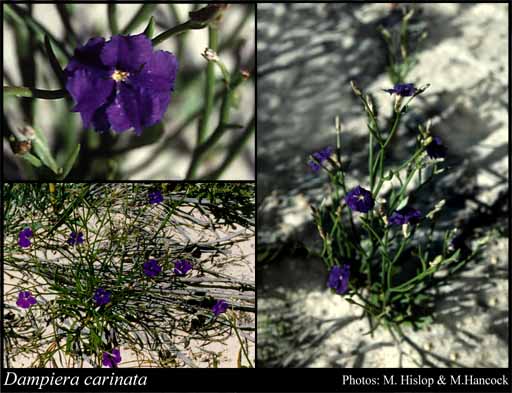- Reference
- Fl.Austral. 4:111 (1868)
- Conservation Code
- Not threatened
- Naturalised Status
- Native to Western Australia
- Name Status
- Current
Erect perennial, herb, 0.1-0.25 m high. Fl. blue/purple, Oct to Dec or Jan to Apr. White/grey or yellow sand. Flats.

Scientific Description
Stems ribbed. Leaves flat, 20-50 mm long, 3-38 mm wide, Indumentum absent (leaves glabrous); margins entire. Bracteoles present, 2-2.5 mm long, glabrous. Pedicel pedicellate, Pedicel length the pedicels 2-6 mm long, Indumentum present, Hair type with simple hairs. Calyx lobes present, Calyx length 3-4 mm long, hairy, with dense, simple hairs. Corolla blue or purple, 7-12 mm long, auriculate, not spurred, hairy on the outside, with dense, simple hairs, glabrous on the inside; central lobes 4-6.5 mm long, with wings; outer lobes 5.5-10 mm long, wings present on both sides, 2-2.5 mm wide. Anthers connate. Ovary inferior, not gibbose; style 3.5-6 mm long, glabrous; indusium single, glabrous; ovules one or two. Flowers in January, February, March, April, October and November. Occurs in the Geraldton Sandplains (GS), Swan Coastal Plain (SWA) and Avon Wheatbelt (AW) IBRA Region(s), of the South West (SW) Botanical Province.
Distribution
- IBRA Regions
- Avon Wheatbelt, Geraldton Sandplains, Swan Coastal Plain.
- IBRA Subregions
- Dandaragan Plateau, Katanning, Lesueur Sandplain, Merredin.
- Local Government Areas (LGAs)
- Carnamah, Coorow, Dandaragan, Gingin, Goomalling, Moora, Quairading, Victoria Plains, Wongan-Ballidu, York.